Analys
Trade war and Nopec-shake, but market looks like tightening

 Brent crude sold off 1.7% yesterday with a close of $61.63/bl but has rebounded 0.4% today trading at $61.8/bl. The sell-off came on the back of a 0.9% decline in S&P 500 and a marginally stronger dollar with DXY now just 0.9% below the highs from late 2018. The clear driver for the sell-off in both crude and equities was the signal from Donald Trump that there will be no trade deal between China and the US before the March 1 deadline runs out. The consequence of this is that tariffs on about $200bn worth of goods from China will increase from 10% to 25% from March 1. It definitely took the air out of growth hopes both for economics and for oil.
Brent crude sold off 1.7% yesterday with a close of $61.63/bl but has rebounded 0.4% today trading at $61.8/bl. The sell-off came on the back of a 0.9% decline in S&P 500 and a marginally stronger dollar with DXY now just 0.9% below the highs from late 2018. The clear driver for the sell-off in both crude and equities was the signal from Donald Trump that there will be no trade deal between China and the US before the March 1 deadline runs out. The consequence of this is that tariffs on about $200bn worth of goods from China will increase from 10% to 25% from March 1. It definitely took the air out of growth hopes both for economics and for oil.
US Nopec legislation (“No Oil Producing and Exporting Cartels Act 2019”) moved forward in the US. The bill was approved by the House judiciary committee on Thursday and is now ready for a full House vote. It will also need to be approved by the US Senate. Given Donald Trump’s known hostile stance towards OPEC it now looks like a very good chance that the bill will actually be voted through without being vetoed down by the President (George W Bush did that last time the bill was promoted). The prospect of a passage of Nopec legislation has added bearish pressure to Brent crude.
We don’t think that OPEC intervention matters all that much in the medium to longer term. After all, it is not low cost OPEC oil which sets the marginal cost of oil in the global market. It is the higher non-OPEC marginal cost which sets the global oil price over time. OPEC can never escape from this fact.
OPEC intervention is however a very important short term oil price driver. It is no doubt that the boost in production by OPEC+ from May to November last year helped to drown the global market in oil and crash the oil price from October to December. It is likewise just as clear that the revival in oil prices since December low of just below $50/bl to a recent high of $63.63/bl has the fingerprint of production cuts agreed by OPEC+ in December all over it.
So if the US Nopec legislation is voted through and becomes law it could definitely be bearish for oil prices right here and now given that OPEC+ is in the midst of tactical production cuts right this moment. The Nopec law will enable the US to prosecute OPEC members for price manipulation and potentially confiscate oil assets in the US belonging to such OPEC members. Whether OPEC members in general and Saudi Arabia specifically would cave in if Nopec becomes law remains to be seen. Qatar however left OPEC in December after 57 years in the group presumably due to the risk of Nopec becoming law.
It is Saudi Arabia which really is the captain of the OPEC ship. It is also Saudi Arabia who really moves supply up and down and moves the market with the other members just pitching in a little. The Nopec legislation could end tactical, cooperative production cuts and increases orchestrated by OPEC. It should probably not hinder Saudi Arabia to move production up and down on its own in order to address tactical turns and imbalances in the global oil market.
The Nopec legislation is however right in the face of Saudi Arabia. If Nopec becomes law it must be very damaging to the long lasting relationship between the US and Saudi Arabia. How can they go on being best palls if the US kills off OPEC as an organisation we wonder? This may be the next step in the geopolitical changes taking place in the Middle East. The US needs the Middle East less due to close to self-sufficiency of oil. China and India needs it more and more along with their rapidly rising oil imports and Russia is eager to get closer ties and influence in the region. Thus geopolitical changes could be the biggest fall-out.
OPEC’s true value strategy is not primarily about holding back supply tactically from existing production capacity from time to time even though this is primarily what the oil market is focusing on. The true strategy for OPEC is to make sure that they do not over-invest in their own low cost oil assets over time. It is about making sure that the global oil price balances on the higher non-OPEC marginal cost and not through over-investments within OPEC ends up balancing on low cost OPEC oil.
Thus OPEC needs to make sure that if global oil demand grows with some 1.4 m bl/d per year, then production growth from OPEC should be materially less than that. Achieving that is not about holding back production in existing capacity. It is about making sure that upstream investments in OPEC are not too high. The true OPEC strategy is thus about investment discipline over time and not about production discipline from existing capacity. On this more strategic issue it is not so clear that Nopec legislation will have all that much impact.
The amount of fossil fuels in the world is in a human perspective more or less infinite. It is all over the place. We are not running out. The price of oil is about how much oil we have above ground and not about how much is in the ground. Thus discipline on investments is OPEC’s true strategy.
As of right now OPEC+ continues to firm up the global market with its tactical tightening agreed upon in December. In addition we are losing volumes in Venezuela and Iran while general Haftar is fighting over the Sharara oil field in Libya.
Our view is that the situation in Venezuela will get worse before it gets better. US sanctions are biting and a visible reflection of that could be the softer shipping rates for Caribbean to the US Gulf trades since early January. I.e. it looks like shipments of oil out of Venezuela are declining further due to US sanctions. There may be a regime shift from Maduro to Guaido sometime in the future but we find it hard to imagine that Maduro will give up easily as he is backed by China and Russia. Even after a potential shift it will take time to revive confidence to international investors (debt holders) and oil service companies as well as all the oil service personnel which has fled the country. Money, people, competence and companies needs to move back to the country and then the oil industry needs to be revived. It is hard to see a strong revival in oil production in Venezuela this year.
Iran is definitely a sad, sad story and US shale oil production boom is bad, bad news for the Iran. Donald Trump handed out handsome oil import waivers to international buyers in Q4-18 in order to avoid a spike in the oil price. However, every additional barrel of oil produced in the US enables the US to reduce the Iran waivers just as much. Thus the more you are bullish US crude production, the more you should expect to see further declines in Iran oil exports along with smaller and smaller US waivers being handed out. Thus more US oil probably means comparably less oil out of Iran. Unfortunately for Iran.
The global economy is of great concern with continued US-China trade war (no resolution by March 1) and weakening outlook in general driving the outlook for global oil demand growth in 2019 lower. Global refining margins have moved down to very weak and painful levels at which refineries becomes increasingly likely to reduce their refining utilization. We are also moving towards the spring (March, April) refinery turnarounds where refineries are taken off-line for maintenance and summer tuning. This should lead to a temporary softer crude market with somewhat weaker crude spot dynamics over the next couple of months which might weight bearishly on crude prices. I.e. crude prices could be more bearishly sensitive to ingredients like a stronger dollar and/or equity sell-offs.
In total and on balance, it still looks like the crude oil market is on a tightening path due to both voluntary and involuntary cuts by OPEC+. Set-backs in the oil price rally since late December is however clearly a risk with Nopec, US-China trade war, global growth concerns, weak refinery margins, US dollar strength and potential sell-offs in the S&P 500 as the main concerns.
Analys
Also OPEC+ wants to get compensation for inflation

Brent crude has fallen USD 3/b since the peak of Iran-Israel concerns last week. Still lots of talk about significant Mid-East risk premium in the current oil price. But OPEC+ is in no way anywhere close to loosing control of the oil market. Thus what will really matter is what OPEC+ decides to do in June with respect to production in Q3-24 and the market knows this very well. Saudi Arabia’s social cost-break-even is estimated at USD 100/b today. Also Saudi Arabia’s purse is hurt by 21% US inflation since Jan 2020. Saudi needs more money to make ends meet. Why shouldn’t they get a higher nominal pay as everyone else. Saudi will ask for it

Brent is down USD 3/b vs. last week as the immediate risk for Iran-Israel has faded. But risk is far from over says experts. The Brent crude oil price has fallen 3% to now USD 87.3/b since it became clear that Israel was willing to restrain itself with only a muted counter attack versus Israel while Iran at the same time totally played down the counterattack by Israel. The hope now is of course that that was the end of it. The real fear has now receded for the scenario where Israeli and Iranian exchanges of rockets and drones would escalate to a point where also the US is dragged into it with Mid East oil supply being hurt in the end. Not everyone are as optimistic. Professor Meir Javedanfar who teaches Iranian-Israeli studies in Israel instead judges that ”this is just the beginning” and that they sooner or later will confront each other again according to NYT. While the the tension between Iran and Israel has faded significantly, the pain and anger spiraling out of destruction of Gaza will however close to guarantee that bombs and military strifes will take place left, right and center in the Middle East going forward.
Also OPEC+ wants to get paid. At the start of 2020 the 20 year inflation adjusted average Brent crude price stood at USD 76.6/b. If we keep the averaging period fixed and move forward till today that inflation adjusted average has risen to USD 92.5/b. So when OPEC looks in its purse and income stream it today needs a 21% higher oil price than in January 2020 in order to make ends meet and OPEC(+) is working hard to get it.
Much talk about Mid-East risk premium of USD 5-10-25/b. But OPEC+ is in control so why does it matter. There is much talk these days that there is a significant risk premium in Brent crude these days and that it could evaporate if the erratic state of the Middle East as well as Ukraine/Russia settles down. With the latest gains in US oil inventories one could maybe argue that there is a USD 5/b risk premium versus total US commercial crude and product inventories in the Brent crude oil price today. But what really matters for the oil price is what OPEC+ decides to do in June with respect to Q3-24 production. We are in no doubt that the group will steer this market to where they want it also in Q3-24. If there is a little bit too much oil in the market versus demand then they will trim supply accordingly.
Also OPEC+ wants to make ends meet. The 20-year real average Brent price from 2000 to 2019 stood at USD 76.6/b in Jan 2020. That same averaging period is today at USD 92.5/b in today’s money value. OPEC+ needs a higher nominal price to make ends meet and they will work hard to get it.
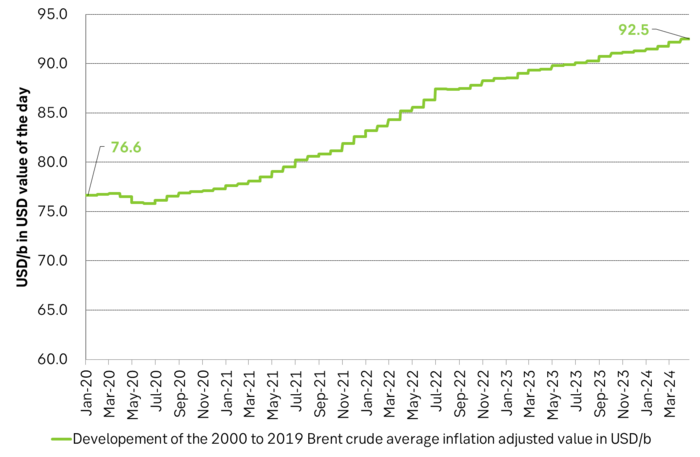
Inflation adjusted Brent crude price versus total US commercial crude and product stocks. A bit above the regression line. Maybe USD 5/b risk premium. But type of inventories matter. Latest big gains were in Propane and Other oils and not so much in crude and products

Total US commercial crude and product stocks usually rise by 4-5 m b per week this time of year. Gains have been very strong lately, but mostly in Propane and Other oils

Last week’s US inventory data. Big rise of 10 m b in commercial inventories. What really stands out is the big gains in Propane and Other oils
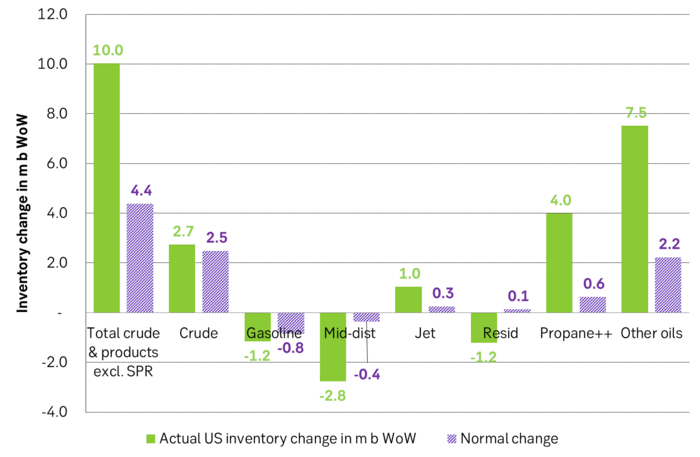
Take actual changes minus normal seasonal changes we find that US commercial crude and regular products like diesel, gasoline, jet and bunker oil actually fell 3 m b versus normal change.

Analys
Nat gas to EUA correlation will likely switch to negative in 2026/27 onward

Historically positive Nat gas to EUA correlation will likely switch to negative in 2026/27 onward

Historically there has been a strong, positive correlation between EUAs and nat gas prices. That correlation is still fully intact and possibly even stronger than ever as traders increasingly takes this correlation as a given with possible amplification through trading action.
The correlation broke down in 2022 as nat gas prices went ballistic but overall the relationship has been very strong for quite a few years.
The correlation between nat gas and EUAs should be positive as long as there is a dynamical mix of coal and gas in EU power sector and the EUA market is neither too tight nor too weak:
Nat gas price UP => ”you go black” by using more coal => higher emissions => EUA price UP
But in the future we’ll go beyond the dynamically capacity to flex between nat gas and coal. As the EUA price moves yet higher along with a tightening carbon market the dynamical coal to gas flex will max out. The EUA price will then trade significantly above where this flex technically will occur. There will still be quite a few coal fired power plants running since they are needed for grid stability and supply amid constrained local grids.
As it looks now we still have such overall coal to gas flex in 2024 and partially in 2025, but come 2026 it could be all maxed out. At least if we look at implied pricing on the forward curves where the forward EUA price for 2026 and 2027 are trading way above technical coal to gas differentials. The current forward pricing implications matches well with what we theoretically expect to see as the EUA market gets tighter and marginal abatement moves from the power sector to the industrial sector. The EUA price should then trade up and way above the technical coal to gas differentials. That is also what we see in current forward prices for 2026 and 2027.
The correlation between nat gas and EUAs should then (2026/27 onward) switch from positive to negative. What is left of coal in the power mix will then no longer be dynamically involved versus nat gas and EUAs. The overall power price will then be ruled by EUA prices, nat gas prices and renewable penetration. There will be pockets with high cost power in the geographical points where there are no other alternatives than coal.
The EUA price is an added cost of energy as long as we consume fossil energy. Thus both today and in future years we’ll have the following as long as we consume fossil energy:
EUA price UP => Pain for consumers of energy => lower energy consumption, faster implementation of energy efficiency and renewable energy => lower emissions
The whole idea with the EUA price is after all that emissions goes down when the EUA price goes up. Either due to reduced energy consumption directly, accelerated energy efficiency measures or faster switch to renewable energy etc.
Let’s say that the coal to gas flex is maxed out with an EUA price way above the technical coal to gas differentials in 2026/27 and later. If the nat gas price then goes up it will no longer be an option to ”go black” and use more coal as the distance to that is too far away price vise due to a tight carbon market and a high EUA price. We’ll then instead have that:
Nat gas higher => higher energy costs with pain for consumers => weaker nat gas / energy demand & stronger drive for energy efficiency implementation & stronger drive for more non-fossil energy => lower emissions => EUA price lower
And if nat gas prices goes down it will give an incentive to consume more nat gas and thus emit more CO2:
Cheaper nat gas => Cheaper energy costs altogether, higher energy and nat gas consumption, less energy efficiency implementations in the broader economy => emissions either goes up or falls slower than before => EUA price UP
Historical and current positive correlation between nat gas and EUA prices should thus not at all be taken for granted for ever and we do expect this correlation to switch to negative some time in 2026/27.
In the UK there is hardly any coal left at all in the power mix. There is thus no option to ”go black” and burn more coal if the nat gas price goes up. A higher nat gas price will instead inflict pain on consumers of energy and lead to lower energy consumption, lower nat gas consumption and lower emissions on the margin. There is still some positive correlation left between nat gas and UKAs but it is very weak and it could relate to correlations between power prices in the UK and the continent as well as some correlations between UKAs and EUAs.
Correlation of daily changes in front month EUA prices and front-year TTF nat gas prices, 250dma correlation.
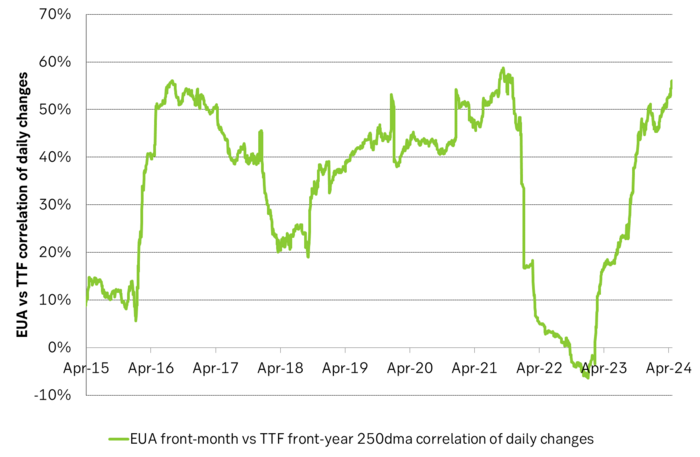
EUA price vs front-year TTF nat gas price since March 2023
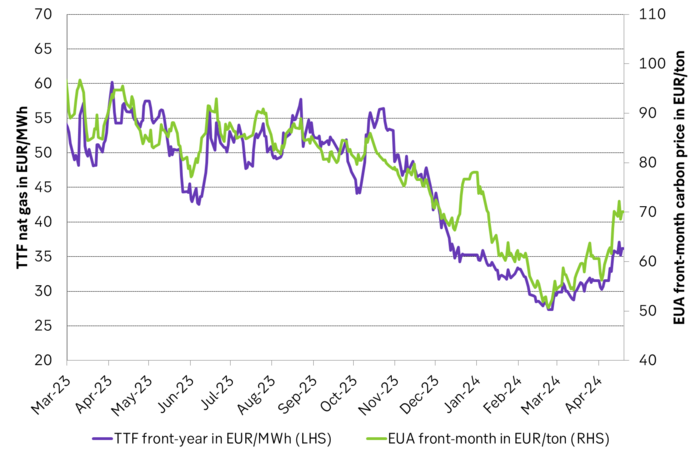
Front-month EUA price vs regression function of EUA price vs. nat gas derived from data from Apr to Nov last year.
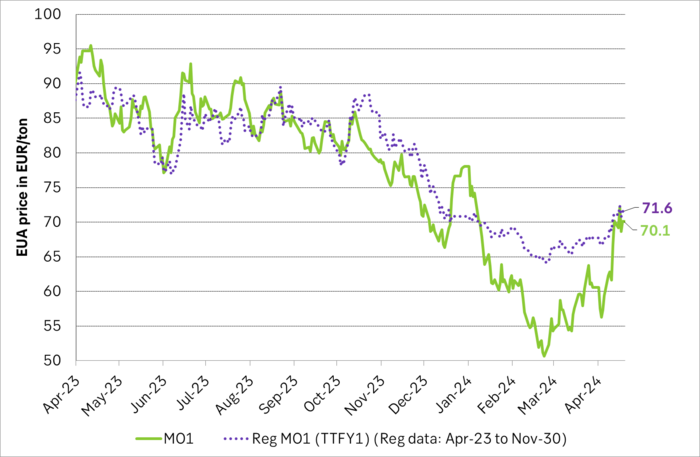
The EUA price vs the UKA price. Correlations previously, but not much any more.
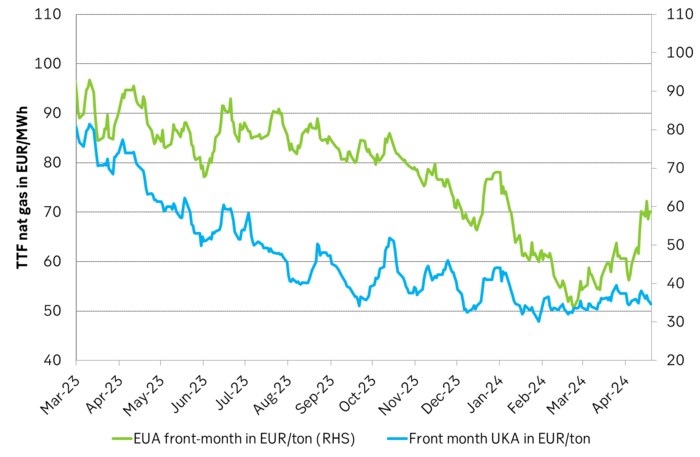
Forward German power prices versus clean cost of coal and clean cost of gas power. Coal is totally priced out vs power and nat gas on a forward 2026/27 basis.

Forward price of EUAs versus technical level where dynamical coal to gas flex typically takes place. EUA price for 2026/27 is at a level where there is no longer any price dynamical interaction or flex between coal and nat gas. The EUA price should/could then start to be negatively correlated to nat gas.

Forward EAU price vs. BNEF base model run (look for new update will come in late April), SEB’s EUA price forecast.
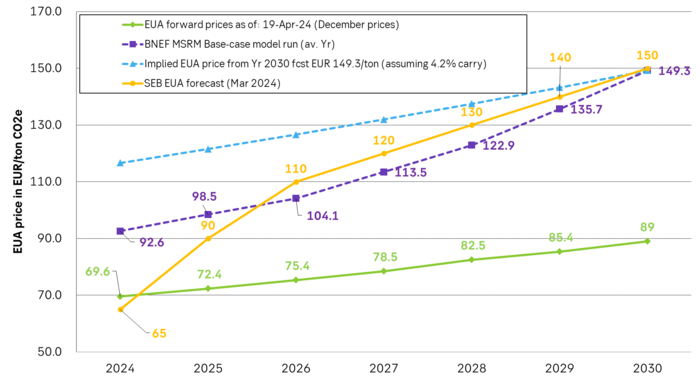
Analys
Fear that retaliations will escalate but hopes that they are fading in magnitude

Brent crude spikes to USD 90.75/b before falling back as Iran plays it down. Brent crude fell sharply on Wednesday following fairly bearish US oil inventory data and yesterday it fell all the way to USD 86.09/b before a close of USD 87.11/b. Quite close to where Brent traded before the 1 April attack. This morning Brent spiked back up to USD 90.75/b (+4%) on news of Israeli retaliatory attack on Iran. Since then it has quickly fallen back to USD 88.2/b, up only 1.3% vs. ydy close.

The fear is that we are on an escalating tit-for-tat retaliatory path. Following explosions in Iran this morning the immediate fear was that we now are on a tit-for-tat escalating retaliatory path which in the could end up in an uncontrollable war where the US unwillingly is pulled into an armed conflict with Iran. Iran has however largely diffused this fear as it has played down the whole thing thus signalling that the risk for yet another leg higher in retaliatory strikes from Iran towards Israel appears low.
The hope is that the retaliatory strikes will be fading in magnitude and then fizzle out. What we can hope for is that the current tit-for-tat retaliatory strikes are fading in magnitude rather than rising in magnitude. Yes, Iran may retaliate to what Israel did this morning, but the hope if it does is that it is of fading magnitude rather than escalating magnitude.
Israel is playing with ”US house money”. What is very clear is that neither the US nor Iran want to end up in an armed conflict with each other. The US concern is that it involuntary is dragged backwards into such a conflict if Israel cannot control itself. As one US official put it: ”Israel is playing with (US) house money”. One can only imagine how US diplomatic phone lines currently are running red-hot with frenetic diplomatic efforts to try to defuse the situation.
It will likely go well as neither the US nor Iran wants to end up in a military conflict with each other. The underlying position is that both the US and Iran seems to detest the though of getting involved in a direct military conflict with each other and that the US is doing its utmost to hold back Israel. This is probably going a long way to convince the market that this situation is not going to fully blow up.
The oil market is nonetheless concerned as there is too much oil supply at stake. The oil market is however still naturally concerned and uncomfortable about the whole situation as there is so much oil supply at stake if the situation actually did blow up. Reports of traders buying far out of the money call options is a witness of that.
-

 Nyheter3 veckor sedan
Nyheter3 veckor sedanGuldpriset når nytt all time high och bryter igenom 2300 USD
-

 Nyheter4 veckor sedan
Nyheter4 veckor sedanLundin Mining får köprekommendation av BMO
-

 Nyheter4 veckor sedan
Nyheter4 veckor sedanVertikal prisuppgång på kakao – priset toppar nu 9000 USD
-

 Nyheter3 veckor sedan
Nyheter3 veckor sedanCentralbanker fortsatte att köpa guld under februari
-

 Nyheter2 veckor sedan
Nyheter2 veckor sedanUSAs stigande konsumtion av naturgas
-

 Nyheter3 veckor sedan
Nyheter3 veckor sedanKakaomarknaden är extrem för tillfället
-

 Nyheter3 veckor sedan
Nyheter3 veckor sedanHur mår den svenska skogsbraschen? Två favoritaktier
-

 Nyheter4 veckor sedan
Nyheter4 veckor sedanBoliden på 20 minuter








